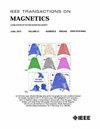Study on Performance Changes of EV Traction Motor Applying CFRP Sleeve to IPMSM
IF 2.1
3区 工程技术
Q3 ENGINEERING, ELECTRICAL & ELECTRONIC
引用次数: 0
Abstract
In general, the interior permanent magnet synchronous motor (IPMSM) is mainly used as the traction motor of electric vehicles. IPMSM uses a rib and bridge structure to prevent permanent magnets (PMs) from being separated by centrifugal force when the motor rotates. Increasing the thickness of the ribs and bridges to satisfy rigidity at high speeds acts as a cause of increased leakage flux, thereby reducing motor performance. In this article, to improve the performance of IPMSM, we benchmark existing products to derive a proto analysis model and verify it through testing. In addition, the rib and bridge shapes that cause leakage flux are removed from the proto model and a carbon fiber-reinforced plastic (CFRP) sleeve is applied. Next, stress analysis is performed to confirm whether the safety factor is met at the required maximum speed. Also, as a result of comparing the no-load characteristics, it was confirmed that the leakage flux decreased and the back electromotive force (Back EMF) increased. However, in the case of the CFRP model with increased Back EMF, the current for field weakening control increases, making it difficult to drive at high speed. Therefore, an improvement design was performed to bring the field weakening current to the same level as the proto model. As a result, the CFRP model had a similar performance to the proto model and improved efficiency.CFRP套筒应用于电动汽车牵引电机的性能变化研究
一般来说,内嵌式永磁同步电机(IPMSM)主要用作电动汽车的牵引电机。IPMSM使用肋和桥结构来防止永磁体(pm)在电机旋转时因离心力而分离。增加肋和桥的厚度以满足高速下的刚性会导致泄漏磁通增加,从而降低电机性能。为了提高IPMSM的性能,本文对现有产品进行了基准测试,得出了一个原型分析模型,并通过测试进行了验证。此外,从原型模型中删除了导致泄漏通量的肋和桥形状,并应用了碳纤维增强塑料(CFRP)套管。接下来,进行应力分析,以确认是否在要求的最大速度下满足安全系数。通过对空载特性的比较,证实了漏电通量减小,反电动势(back EMF)增大。然而,在反电动势增加的CFRP模型中,用于弱磁场控制的电流增加,使其难以在高速下驱动。因此,进行了改进设计,使磁场弱化电流达到与原型模型相同的水平。结果表明,CFRP模型具有与原型模型相似的性能,并且提高了效率。
本文章由计算机程序翻译,如有差异,请以英文原文为准。
求助全文
约1分钟内获得全文
求助全文
来源期刊

IEEE Transactions on Magnetics
工程技术-工程:电子与电气
CiteScore
4.00
自引率
14.30%
发文量
565
审稿时长
4.1 months
期刊介绍:
Science and technology related to the basic physics and engineering of magnetism, magnetic materials, applied magnetics, magnetic devices, and magnetic data storage. The IEEE Transactions on Magnetics publishes scholarly articles of archival value as well as tutorial expositions and critical reviews of classical subjects and topics of current interest.
 求助内容:
求助内容: 应助结果提醒方式:
应助结果提醒方式:


